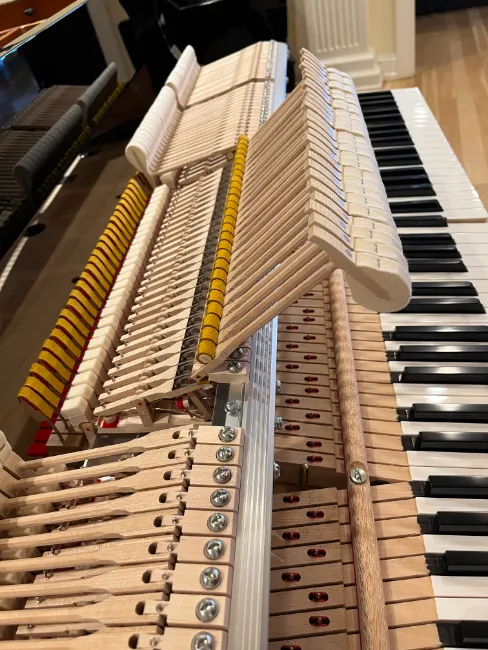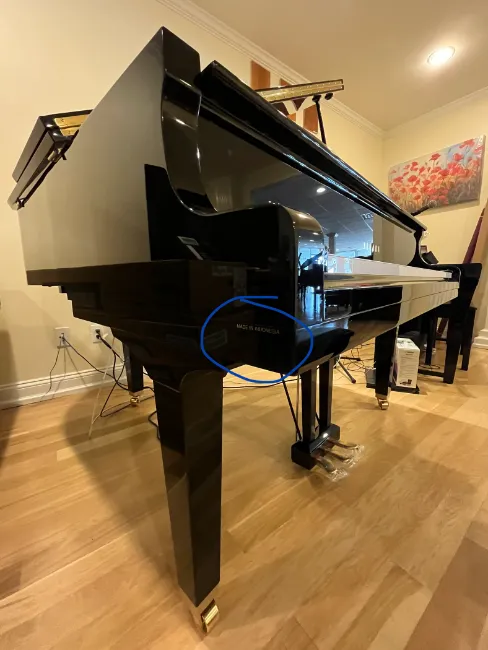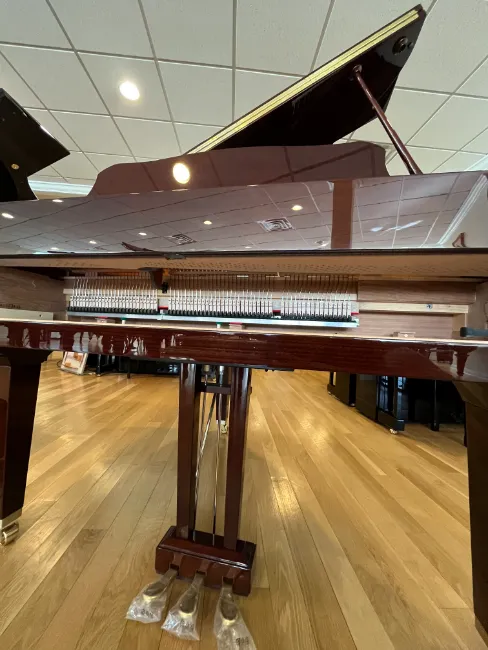Yamaha GB1K Baby Grand Piano Review: 2025

My first hand experience comes from being a piano technician/tuner who works especially with brand new Yamaha pianos.
I will be reviewing the GB1K which is the smallest model baby grand piano that Yamaha has to offer measuring 5ft in length.
This musical instrument remains the best selling baby grand piano for its value and price.
Tech Takeaways (TLDR)
If you’re going to buy a GB1K, get it in Mahogany for better tone.
GC1’s are worth the extra money; if you’re looking for base-line high-quality baby grands.
Compare the GB1K to its superior-adjacent: Yamaha GC1 vs. GB1K Review
May be equipped with a player piano system that plays itself called Disklavier
In the United States, Yamaha pianos are the industry standard among Americans, which is part of why this model is incredibly popular.
Technical perspective:
Without taking a close look at this particular tier of product, it’s not obvious which details a technician like me could point out right away.
I will explain some of the things I notice as a technician to give the clearest picture about this model piano.
For background, the grandfather of the GB1K is the GA1 which has the same sized foot print of the GB1K.
This piano is a great instrument for piano students who can expect a clean functioning action, and a piano that genuinely sounds good when it is regularly tuned.
The bass strings are very easy to tune and do not have inharmonicity and tonality issues like the previous versions of Yamaha pianos this size (GA1 & GH1).
While this instrument has its pluses and minuses, the quality control at Yamaha is exceptional, so one baby grand to the next will be identical, and I mean it!
What are some critiques of the GB1K?
This piano tends to need tuning more often when compared with the GC1 and C series grands which are the adjacent models ranked above the GB1K.
This piano has shorter strings due to its smaller size which limits its depth of tone, and to some extent, versatility of the instrument.
To me, this makes it feel like you can really only ask so much of this piano in terms of moods and emotion that you'll ordinarily find with a larger piano. This is because it simply does not have as much space within the cabinet for the sound to fully develop.
This Yamaha baby grand is far too small for concert halls, so it wouldn't be a good fit for such a large atmosphere.
I will admit that the "action" functions very cleanly (usually after fixing a sticky/sluggish key or two).
However, the action feels slower when compared with medium and concert sized Yamaha pianos (this observation is generally made by highly skilled piano players). For trickier musical pieces think, accessibility.
What do people say about the GB1K?
In spite of my critiques, I know a piano technician who said her dream piano is a GB1K because she essentially told me that it was the perfect size and value for the best price, and nothing in the world would stop her from getting anything else!
Side note: Amongst technicians, we never say, “oh, this is the best baby grand piano." It’s because we ordinarily don't consider baby grands to be among one of our choices to begin with!
But for my colleague, she had a mind of her own…
How do I buy a Yamaha GB1K?
Email my Colleague: Peter Creighton Email
*Tell ‘em “Kevin B.” sent you
Yamaha: The maker of GB1K, C series, CX series, and CF grands
*I am of the opinion, especially when it comes to Yamaha grand pianos, that they don't really get "good" until they become larger in size, like when you get to the C series or even a GC1. (I love GC1’s)
I must admit, however, that Yamaha produces outstanding pianos at some of the most competitive pricing, whether an upright piano or a grand piano.
Yamaha customers know that signature "Yamaha Sound" and will not be disappointed by this instrument. The sound quality truly resembles the tone quality of what you would expect in a Yamaha piano, albeit a smaller one.
Yamaha is a very popular choice for the enthusiastic beginner, piano player or regular folk who recognize their global reputation.
Yamaha has created a global network of open dialog between piano dealers, technicians, and customers who then work together to improve the quality of the product to continue to provide the tools for musicians to successfully express themselves.
The Yamaha reputation rests with those who play their pianos, and as a result, they have earned their position as a favorite brand in the United States among Americans.
Based off of the fact that Yamaha has produced over 10 million pianos, there are quite a lot of Yamaha customers who believe in the quality of their products.
I do believe that Yamaha makes some of the worlds best pianos, and they currently offer the new GB1K to reach a certain price point to reach a broad customer base.
Is the GB1K made in Indonesia?
As you can see here in the picture, Yamaha proudly displays that these instruments are in fact made in Jakarta, Indonesia.
The first way you can tell is by looking at the left hand side of the piano where it will either say "Made in Japan" or "Made in Indonesia."
The other way you can tell if the piano was made in Indonesia is by looking at the serial number. If at the beginning of the serial number there is a "J" for Jakarta, you are able to prove that it was made in Jakarta, Indonesia.
Polished Walnut Furniture
The photos to follow are of a GB1K in Polished Walnut.
What colors/finishes are available on a GB1K?
You may order a GB1K in polished white, mahogany, polished ebony, satinized, etc. however, it may have to be specially ordered.
I find that the Mahogany GB1K's tend to sound a bit darker possibly because the way in which the sound reverberates throughout the rim differently due to the density of the wood. (Denser than oak).
*GB1K’s in Mahogany are my personal favorite for this very reason. The darker/richer sound, plus the cabinet truly looks incredible. Once you develop an eye for it, it completely changes your perspective.
How much is a Yamaha GB1K?
Email my Colleague for direct pricing: Peter Creighton Email
Peter Creighton
Need a cheat sheet for negotiating price? See the Piano Buyer Book on Amazon
Read: My Review of the Piano Buyer Book
Save thousands of dollars with this $20 book.
While the Yamaha baby Grand Piano has cost-saving advantages, beware that your piano tuner will know that it needs a bit of extra tunings early on in the life of this piano until it settles, which ordinarily takes a series of 2-7 years (In which case, slightly aged pianos are often preferable in my opinion).
The action may be a bit slower than other classic piano models which may cost a few extra hours of technician labor in your home, and even then you may find that the action does not respond quite as quickly as highly proficient pianists would hope.
Even for well experienced pianists, the smaller grand Yamaha models such as the GB1K have slightly heavier/less responsive actions which does make playing quick excerpts for accomplished pianists inaccessible. (See GC1)
On the bright side, If you’re looking for a Yamaha grand at one of the best price point for a brand new baby grand, this instrument is a great choice to "get your foot in the door" when buying a brand new baby grand piano.
If you look into the cabinet here, you can see that the plate of this new GB1K is darker than earlier versions. It turns out that the newest pianos all have a slightly darker color on the plate.
What's the size and dimensions of a GB1K?
This piano is very short at only 5ft in length, however, it may not be very noticeable to the untrained eye because the piano is proportional in size and shape.
A look Inside of the "belly"
I thought it would be cool to take these photos of the inside of the belly of the piano where you can see the dampers and the underside of the pin block.
Up close, you can see each of the holes drilled for the pins as well as the circular dots on the bottom of the key bed where the "action" primarily rests when "bedded" properly.
Now, this is a super-duper cool photo because you can see over the soundboard, yet underneath the strings while also having a side view of the row of dampers.
If you take a close look at the bottom of the dampers, you can see how dark composite parts are implemented. This is the case as well for superior models of Yamaha grands.
At the end of the day, the last component a technician wants to replace is a broken Damper flange, which is why I suspect Yamaha decided to switch to a robust composite part for this part of the action.
What's better than a Yamaha GB1K baby grand piano?
Larger models starting with the GC1 are actually an ideal baseline piano for home use in my personal and professional opinion.
Compare the GB1K to its superior-adjacent: Yamaha GC1 vs. GB1K Review
Although, when it comes to schools or churches a C1 or larger is recommended by most sales professionals, especially in the case of a large auditorium and may be more appropriate for a small sized venue.
*Yamaha has made substantial refinements from the GA1 to the GB1K. For instance, there once was poor tone quality on a couple key notes in the bass section of the GA1 that have since been completely eliminated in a GB1K.
This model is produced to be an affordable instrument, so there are some pros and cons to that effect.
The music desk is the same in comparison to the larger models of grand pianos made by Yamaha.
The significant advances in tone quality from the GB1K to the GC1 allow classical pieces to fully "bloom" on the instrument, which is why I would personally choose a GC1 over a GB1K in addition to reasons of better playability.
What do pianists say about the GB1K?
Some pianists have remarked that they feel like the action needs a little more lubrication or that it has a slower responsive touch of grand pianos due to the keys feeling slightly heavier.
Many highly value that this piano because it has the same great look of a grand piano while remaining an affordable option. This may be in fact why my colleague loves the GB1K so much; it's one of the most affordable ways/best deals to get a new baby grand into your home.
What are the benefits of a Yamaha GB1K Baby Grand?
The duplex scaling is similar with other high end pianos, so this feature is also within reach for those who decide to get a baby grand.
Some people really want to have a small size baby grand so that it is not obtrusive in their home. Although I may complain about certain musical aspects as well as the feel of the action, it is a great piano for most people who aren't too picky when it comes to enjoying their piano.
I would not recommend it for serious piano players because playing this piano has limitations with the responsiveness of the action, the sound profile of musical expression, and the frequency of tuning required to persistently enjoy this instrument. All of that "goes away" when you start looking into the GC1 or C series models.
While I know many details of this model piano, if you're looking to upgrade your student's music education, I consider this instrument to be a serious upgrade when compared with pianos that are 50+ years old and could really use an upgrade.






















